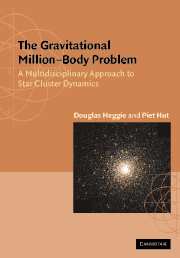Book contents
- Frontmatter
- Contents
- Preface
- PART I INTRODUCTIONS
- PART II THE CONTINUUM LIMIT: N → ∞
- PART III MEAN FIELD DYNAMICS: N = 106
- PART IV MICROPHYSICS: N = 2
- PART V GRAVOTHERMODYNAMICS: N = 106
- PART VI GRAVITATIONAL SCATTERING: N = 3
- PART VII PRIMORDIAL BINARIES: N = 4
- PART VIII POST-COLLAPSE EVOLUTION: N = 106
- PART IX STAR CLUSTER ECOLOGY
- Appendix A A Simple N-Body Integrator
- Appendix B Hints to Solution of Problems
- References
- Index
PART III - MEAN FIELD DYNAMICS: N = 106
Published online by Cambridge University Press: 05 June 2012
- Frontmatter
- Contents
- Preface
- PART I INTRODUCTIONS
- PART II THE CONTINUUM LIMIT: N → ∞
- PART III MEAN FIELD DYNAMICS: N = 106
- PART IV MICROPHYSICS: N = 2
- PART V GRAVOTHERMODYNAMICS: N = 106
- PART VI GRAVITATIONAL SCATTERING: N = 3
- PART VII PRIMORDIAL BINARIES: N = 4
- PART VIII POST-COLLAPSE EVOLUTION: N = 106
- PART IX STAR CLUSTER ECOLOGY
- Appendix A A Simple N-Body Integrator
- Appendix B Hints to Solution of Problems
- References
- Index
Summary
We continue the emphasis on collective effects, i.e. those in which individual interactions between stars are of no importance, but we increasingly focus on those effects that really matter in the million-body problem. Chapter 10 opens with a brief discussion of the notions of equilibrium and stability in this context, but is largely concerned with non-equilibrium phenomena: phase mixing and ‘violent’ relaxation. Another mechanism for evolution of the distribution function, even in static potentials, is diffusion by chaotic motions.
Chapter 11 introduces a variant with a strong astrophysical motivation: the behaviour of N-body systems consisting of particles with time-dependent masses, and how this affects the energy and spatial scale of the system. Much depends on whether the variation is rapid or slow, and in the latter case we can easily study its effect on the distribution function itself.
Again motivated by the astrophysical setting, Chapter 12 introduces the effect of a steady external potential. The problem closely resembles an important idealised version of the motion of the Moon around the Earth under the external perturbing effect of the Sun (Hill's problem). We study the non-integrable motions in this potential, and the important problem of escape. The study is then extended to the case, even more important in applications, of an unsteady external potential.
- Type
- Chapter
- Information
- The Gravitational Million–Body ProblemA Multidisciplinary Approach to Star Cluster Dynamics, pp. 91Publisher: Cambridge University PressPrint publication year: 2003

